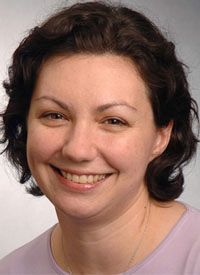Article
AYA Patients With Cancer Want to Know More About Prognosis
Author(s):
Adolescent and young adult patients with cancer placed a high importance on prognostic information, and obtaining that knowledge was associated with improved well-being.
Jennifer W. Mack, MD, associate professor of oncology and urology at Johns Hopkins Medicine

Jennifer W. Mack, MD
Adolescent and young adult (AYA) patients with cancer placed a high importance on prognostic information, and obtaining that knowledge was associated with improved well-being, according to survey results published in the Journal of Clinical Oncology.
Investigators found that 83% of AYA patients felt that knowing the odds on whether their cancer could be cured was “extremely or very important.” The research team was surprised to learn that, among AYA patients, age apparently had no impact on patients’ desire for more prognostic information (P = .56). They had expected younger patients to be less concerned.
“Rather than assuming that young patients may not want such information, oncologists should recognize that most AYAs want to hear about chances of cure,” Jennifer W. Mack, MD, Dana-Farber Cancer Institute, and colleagues wrote. “Although fewer patients with poor prognoses indicated this preference, even among these patients, more than two-thirds want prognostic information.”
After adjusting for patient age, sex, race or ethnicity, prognosis, and diagnosis, more prognostic disclosure was associated with greater trust in the in the oncologist (odds ratio [OR], 1.30; 95% CI, 1.01-1.67; P = .05), hope related to physician communication (OR, 1.27; 95% CI, 1.01-1.59; P = .04), and patient peace of mind (OR, 2.13; 95% CI, 1.29-3.51; P = .002).
While there appeared to be no relationship between prognostic disclosure and depression and anxiety, patients who received more disclosure reported experiencing lower distress related to prognosis (OR, 0.65; 95% CI, 0.44-0.95; P = .03).
A total of 203 patients who were treated for newly diagnosed cancer at Dana-Farber from April 2014 to October 2017 completed surveys exploring their experiences with prognosis communication. Patients were also asked about their prognostic awareness, desire for information, and the outcomes of prognostic disclosure, including psychological effect.
Dana-Farber oncologists (N = 99) completed surveys on 185 (91%) study participants.
Patients were stratified into cohorts of 15 to 17 years (25%), 18 to 21 years (21%), and 22 to 29 years (54%). Approximately one-third of patients were diagnosed with lymphoma, 16% had sarcoma, 14% had genitourinary cancers, and 13% were diagnosed with leukemia.
Most patients (58%) reported living with or being “completely financially dependent” on parents or guardians.
Patients with a better prognosis were more likely than those with a <50% likelihood of cure to consider prognostic information to be important (86% vs 69%; P = .01). However, patients with poor prognosis were more likely to want more information (36% vs 18%; P = .008).
There was no correlation between age and patients who considered knowing about the odds of cure to be extremely or very upsetting (P = .40). Of those 19 patients, 8 (42%) wanted more prognostic information.
Receiving numeric prognostic information was “extremely or very important” to 76% of patients. That desire that was independent of age (P = .25) and prognosis (P = .27). Patients who had more independence were more likely to want numeric information (82% vs 72%; P = .06).
Eighty-eight percent of patients said their oncologist had discussed prognosis, and 82% said their oncologist volunteered that information without being asked. Forty-three patients (21%) said they wanted more information from their oncologist, while 77% felt they had the right amount of information about prognosis.
Mack et al collected 181 matched surveys from patients and their oncologist. Among patients with a <50% chance for cure, 69% said their oncologist had discussed potential outcomes compared with 92% of patients with a better prognosis (P <.001).
Twenty-four percent of oncologists said their patients had a >90% chance of cure compared with 61% of the patients. Furthermore, only 5% of patients felt their chance for cure was <50% compared with 22% of oncologists. While oncologists told 5 patients their cancer was incurable, no patient reported a diagnosis of incurable cancer.
Seven percent of patients underestimated their prognosis, while 62% overestimated. Patients and oncologists were in agreement on the probability of cure 31% of the time. More extensive prognostic disclosure (P = .79), high-quality information (P = .30), and high-quality oncologist communication (P = .84), did not appear to have an effect on patient-oncologist agreement.
“Exploring information preferences and tailoring information delivery to the needs of the patient, including how information should be delivered and who should be present for conversations, should be our standard,” Mack et al wrote. “Discussions about prognosis, no matter how hopeful, implicitly touch on the possibility of death. Many young people may consider these issues deeply but lack the opportunity to express worries about the future unless providers offer time and space for such conversations.”
Mack JW, Fasciano KM, Block SD. Communication about prognosis with adolescent and young adult patients with cancer: information needs, prognostic awareness, and outcomes of disclosure [published online April 23, 2018]. J Clin Oncol. doi: 10.1200/JCO.2018.78.2128.







